Loss of Control Prediction for Motorcycles during Emergency Braking Maneuvers Using a Supervised Learning Algorithm †
Abstract
1. Introduction
2. Materials and Methods
2.1. Participants
2.2. Equipment and Data Collection
2.3. Protocol of the Experiment
2.4. Loss of Control Predictive Model Development
2.4.1. Loss of Control Identification by Video Analysis
2.4.2. Selection of Predictor Variables
2.4.3. Regression Model Algorithm
- Model-1: ‘basic’ model with maximum and RMS parameters as input variables from the signals collected, including the instantaneous magnitude of the resultant gyro vector (Gyro Norm), that is estimated by computing the square root of the sum of the squares of the three gyro components X, Y and Z.
- Model-2: ‘extended’ model with input variables from Model-1 adding maximum and RMS from the computed differentials for the gyro and steering angle signals.
- Model-3: ‘advanced’ version of Model-2, which also contains as input the peak-to-RMS ratio for each of the signals. For real-time assessment, this model requires more computation time for the differential of the signals and for extracting the ratio of two parameters that needed to be calculated previously.
2.4.4. Performance of the Model (ROC and AUC)
2.4.5. Performance of the Single Predictors (ROC and AUC)
2.5. Loss of Control Detection Model for Time Series
3. Results
3.1. Consistency of the Loss of Control Rating
3.2. Selection of Input Features
3.2.1. Preliminary Analysis
3.2.2. Descriptive Analysis
3.3. Predictive Models
3.4. Performance of the Single Predictors
3.5. Loss of Control Predictive Model for Time Series data
4. Discussion
Author Contributions
Funding
Acknowledgments
Conflicts of Interest
References
- Cossalter, V.; Lot, R.; Maggio, F. On the braking behavior of motorcycles. SAE Trans. 2004, 18, 2004. [Google Scholar]
- Fredriksson, R.; Sui, B. Powered two-Wheeler accidents in Germany with severe injury outcome-Accident scenarios, injury sources and potential countermeasures. In Proceedings of the IRCOBI Conference, Malaga, Spain, 14–16 September 2016; Available online: http://www.ircobi.org/wordpress/downloads/irc16/pdf-files/11.pdf (accessed on 2 March 2020).
- Corno, M.; Savaresi, S.M.; Tanelli, M.; Fabbri, L. On optimal motorcycle braking. Control. Eng. Pract. 2008, 16, 644–657. [Google Scholar] [CrossRef]
- Sharp, R.S. Limit braking of a high-performance motorcycle. Veh. Syst. Dyn. 2009, 47, 613–625. [Google Scholar] [CrossRef]
- Baldanzini, N.; Huertas-Leyva, P.; Savino, G.; Pierini, M. Rider Behavioral Patterns in Braking Maneuvers. Transp. Res. Procedia. 2016, 14, 4374–4383. [Google Scholar] [CrossRef]
- Gail, J.; Funke, J.; Seiniger, P.; Westerkamp, U. Anti Lock Braking And Vehicle Stability Control For Motorcycles-Why or Why Not? In Proceedings of the 21st ESV Conference, Stuttgart, Germany, 15–18 June 2009. [Google Scholar]
- Seiniger, P.; Schröter, K.; Gail, J. Perspectives for motorcycle stability control systems. Accid. Anal. Prev. 2012, 44, 74–81. [Google Scholar] [CrossRef] [PubMed]
- Symeonidis, I.; Kavadarli, G.; Erich, S.; Graw, M.; Peldschus, S. Analysis of the stability of PTW riders in autonomous braking scenarios. Accid. Anal. Prev. 2012, 49, 212–222. [Google Scholar] [CrossRef] [PubMed]
- Savino, G.; Pierini, M.; Thompson, J.; Fitzharris, M.; Lenné, M.G. Exploratory field trial of motorcycle autonomous emergency braking (MAEB): Considerations on the acceptability of unexpected automatic decelerations. Traffic Inj. Prev. 2016, 17, 855–862. [Google Scholar] [CrossRef] [PubMed]
- Bellati, A.; Cossalter, V.; Lot, R.; Ambrogi, A. Preliminary investigation on the dynamics of motorcycle fall behavior: Influence of a simple airbag jacket system on rider safety. In Proceedings of the 6th International Motorcycle Conference, IFZ Institute for Motorcycle Safety, Cologne, Germany, 9–10 October 2006. [Google Scholar]
- Cossalter, V.; Aguggiaro, A.; Debus, D.; Bellati, A.; Ambrogi, A. Real cases motorcycle and rider race data investigation: Fall behavior analysis. In Proceedings of the International Technical Conference on the Enhanced Safety of Vehicles (ESV) National Highway Traffic Safety Administration (No. 07-0342), Lyon, France, 18–21 June 2007. [Google Scholar]
- Attal, F.; Boubezoul, A.; Oukhellou, L.; Cheifetz, N.; Espie, S. The Powered Two Wheelers fall detection using Multivariate CUmulative SUM (MCUSUM) control charts. In Proceedings of the 17th International IEEE Conference on Intelligent Transportation Systems (ITSC), Qingdao, China, 8–11 October 2014. [Google Scholar]
- Boubezoul, A.; Espié, S.; Larnaudie, B.; Bouaziz, S. A simple fall detection algorithm for powered two wheelers. Control. Eng. Pract. 2013, 21, 286–297. [Google Scholar] [CrossRef]
- Shinar, D. Traffic Safety and Human Behavior; Elsevier: Oxford, UK, 2007. [Google Scholar]
- Giovannini, F.; Baldanzini, N.; Pierini, M. Development of a Fall Detection Algorithm for Powered Two Wheelers Application. SAE Tech. Pap. 2014. [Google Scholar] [CrossRef]
- Huertas-Leyva, P.; Nugent, M.; Savino, G.; Pierini, M.; Baldanzini, N.; Rosalie, S. Emergency braking performance of motorcycle riders: Skill identification in a real-life perception-action task designed for training purposes. Transp. Res. Part. F Traffic Psychol. Behav. 2019, 63, 93–107. [Google Scholar] [CrossRef]
- Hallgren, K.A. Computing Inter-Rater Reliability for Observational Data: An Overview and Tutorial. Tutor. Quant. Methods Psychol. 2012, 8, 23–34. [Google Scholar] [CrossRef] [PubMed]
- Mcgraw, K.O.; Wong, S.P. Forming inferences about some intraclass correlation coefficients. Psychol. Methods 1996, 1, 30–46. [Google Scholar] [CrossRef]
- Bursac, Z.; Gauss, C.H.; Williams, D.K.; Hosmer, D.W. Purposeful selection of variables in logistic regression. Source Code Biol. Med. 2008, 3, 1–8. [Google Scholar] [CrossRef] [PubMed]
- Krzanowski, W.J.; Hand, D.J. ROC Curves for Continuous Data; Chapman and Hall/CRC: New York, NY, USA, 2009. [Google Scholar]
- Fawcett, T. An introduction to ROC analysis. Pattern Recognit. Lett. 2006, 27, 861–874. [Google Scholar] [CrossRef]
- Cicchetti, D.V. Guidelines, criteria, and rules of thumb for evaluating normed and standardized assessment instruments in psychology. Psychol. Assess. 1994, 6, 284–290. [Google Scholar] [CrossRef]
- Marumo, Y.; Katagiri, N. Control effects of steer-by-wire system for motorcycles on lane-keeping performance. Veh. Syst. Dyn. 2011, 49, 1283–1298. [Google Scholar] [CrossRef]
- Lot, R.; Fleming, J. Gyroscopic stabilisers for powered two-wheeled vehicles. Veh. Syst. Dyn. 2019, 5, 1381–1406. [Google Scholar] [CrossRef]
- Savino, G.; Giovannini, F.; Baldanzini, N.; Pierini, M.; Rizzi, M. Assessing the potential benefits of the motorcycle autonomous emergency braking using detailed crash reconstructions. Traffic Inj. Prev. 2013, 14, S40–S49. [Google Scholar] [CrossRef] [PubMed]
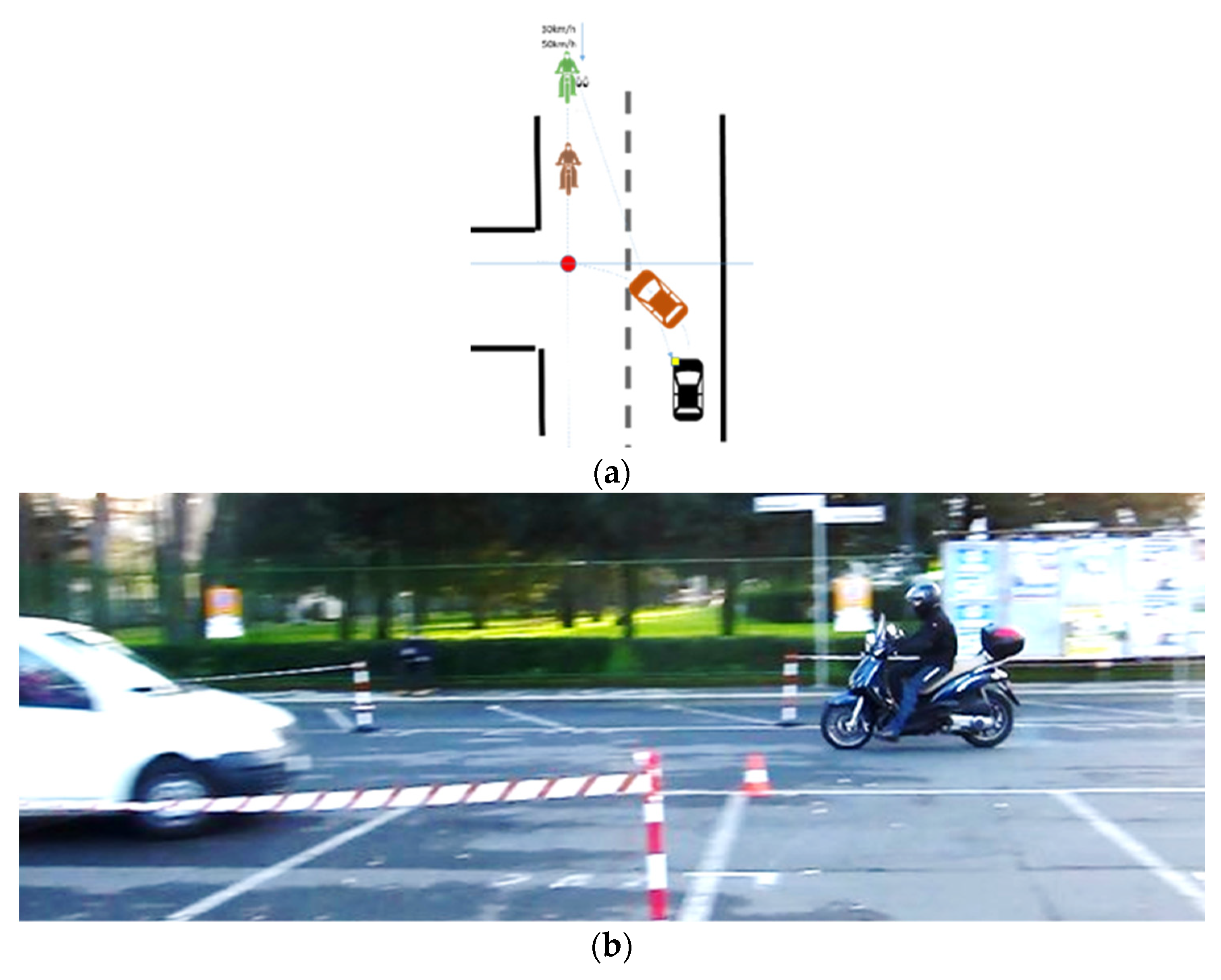
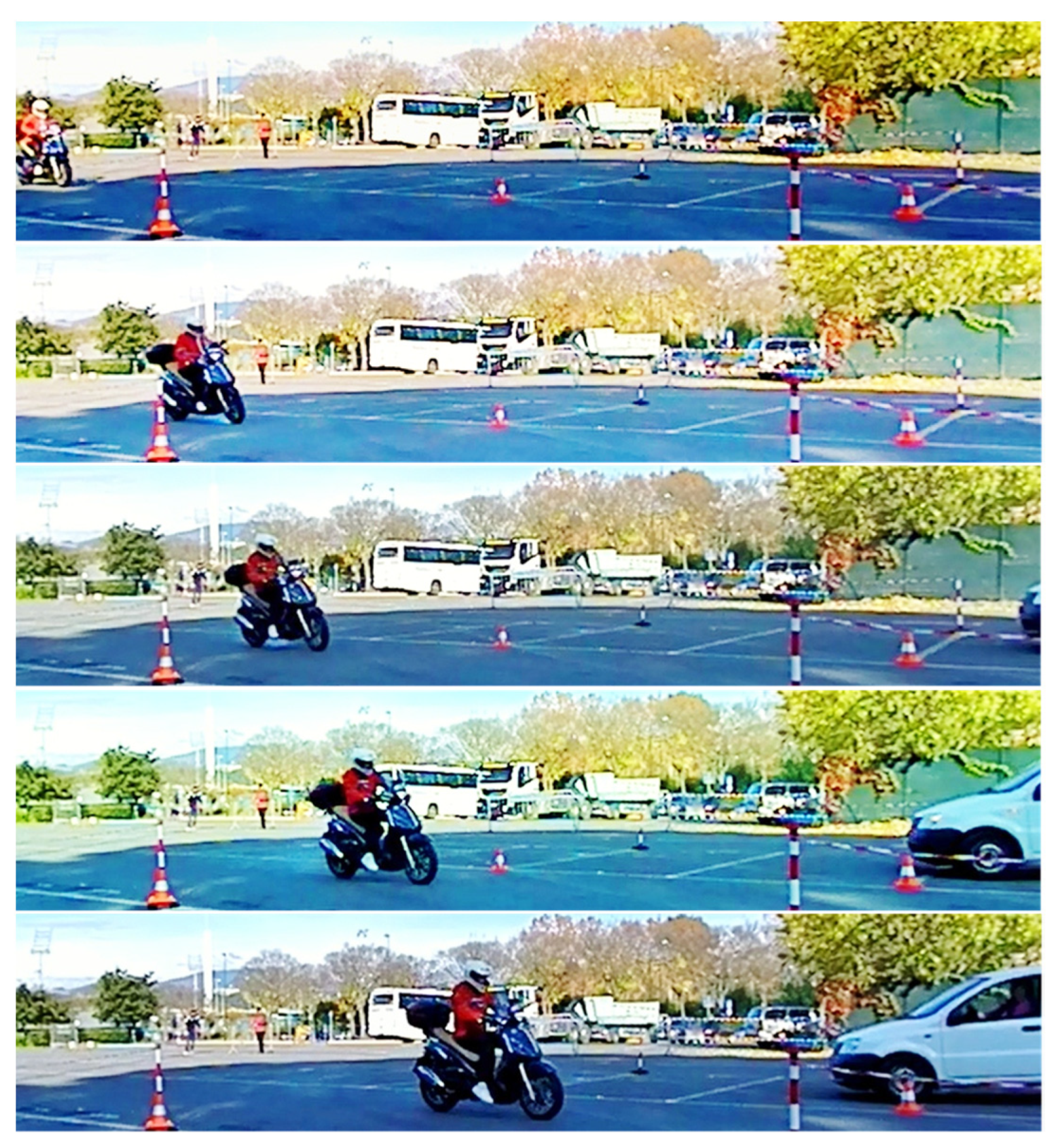
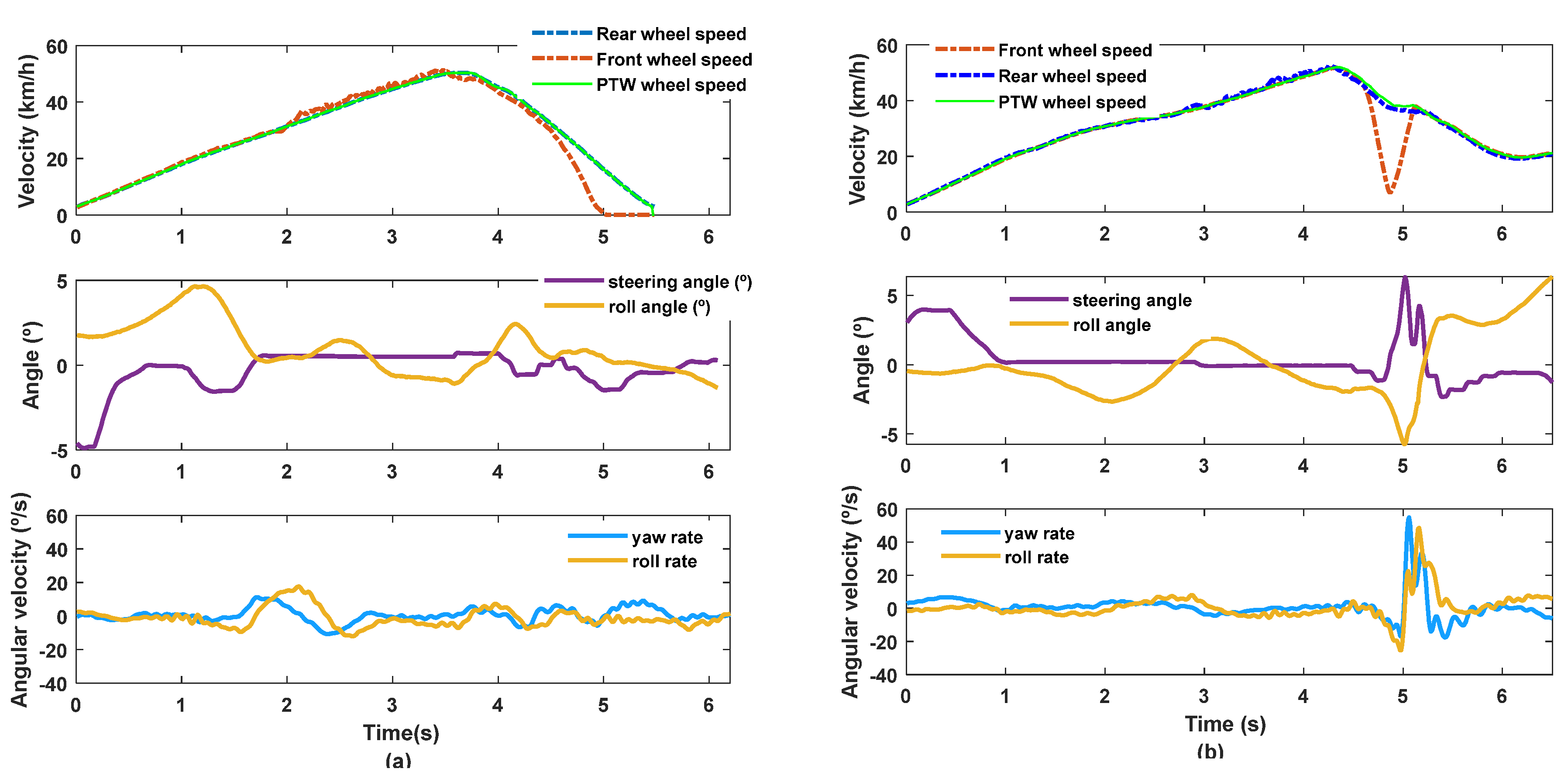
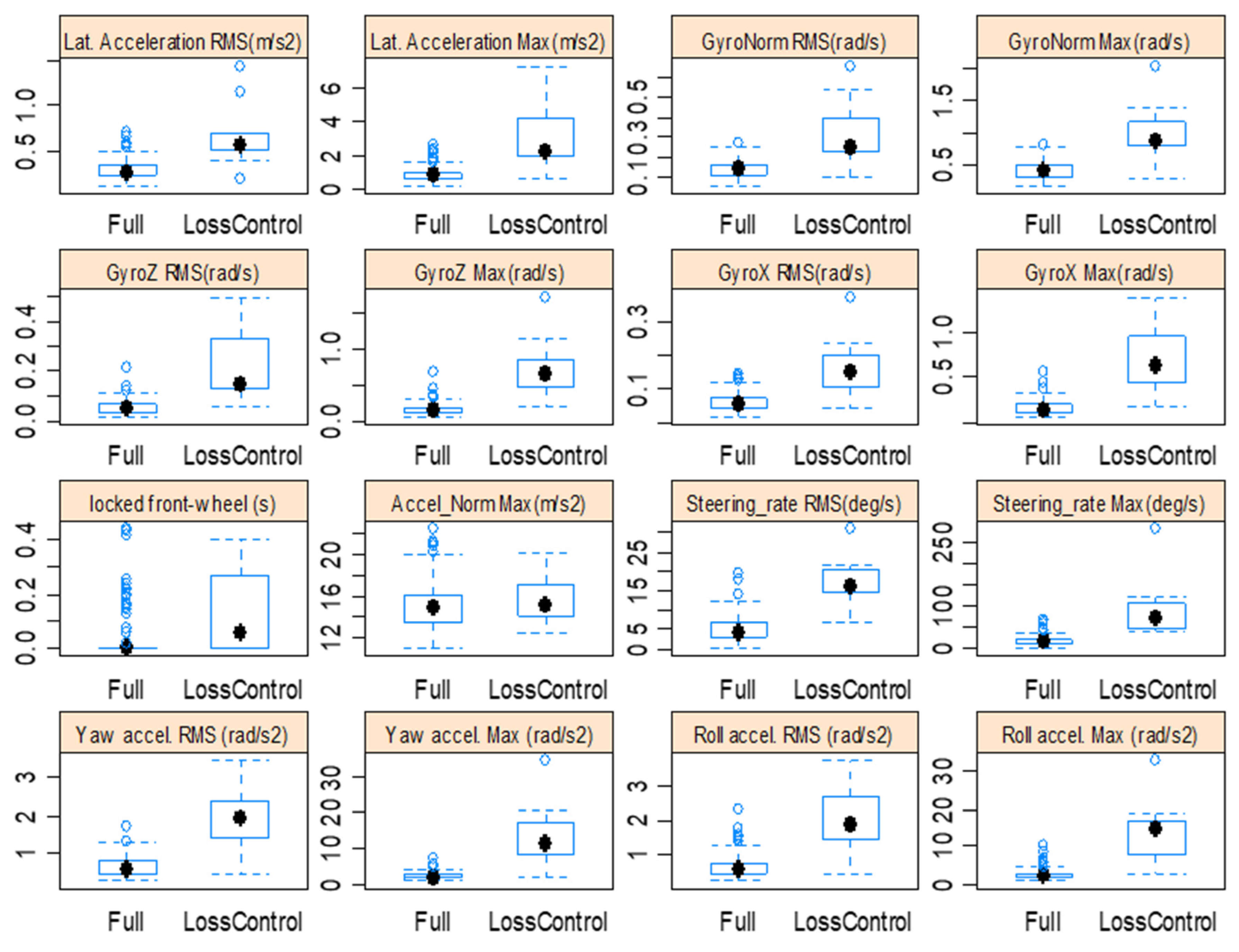
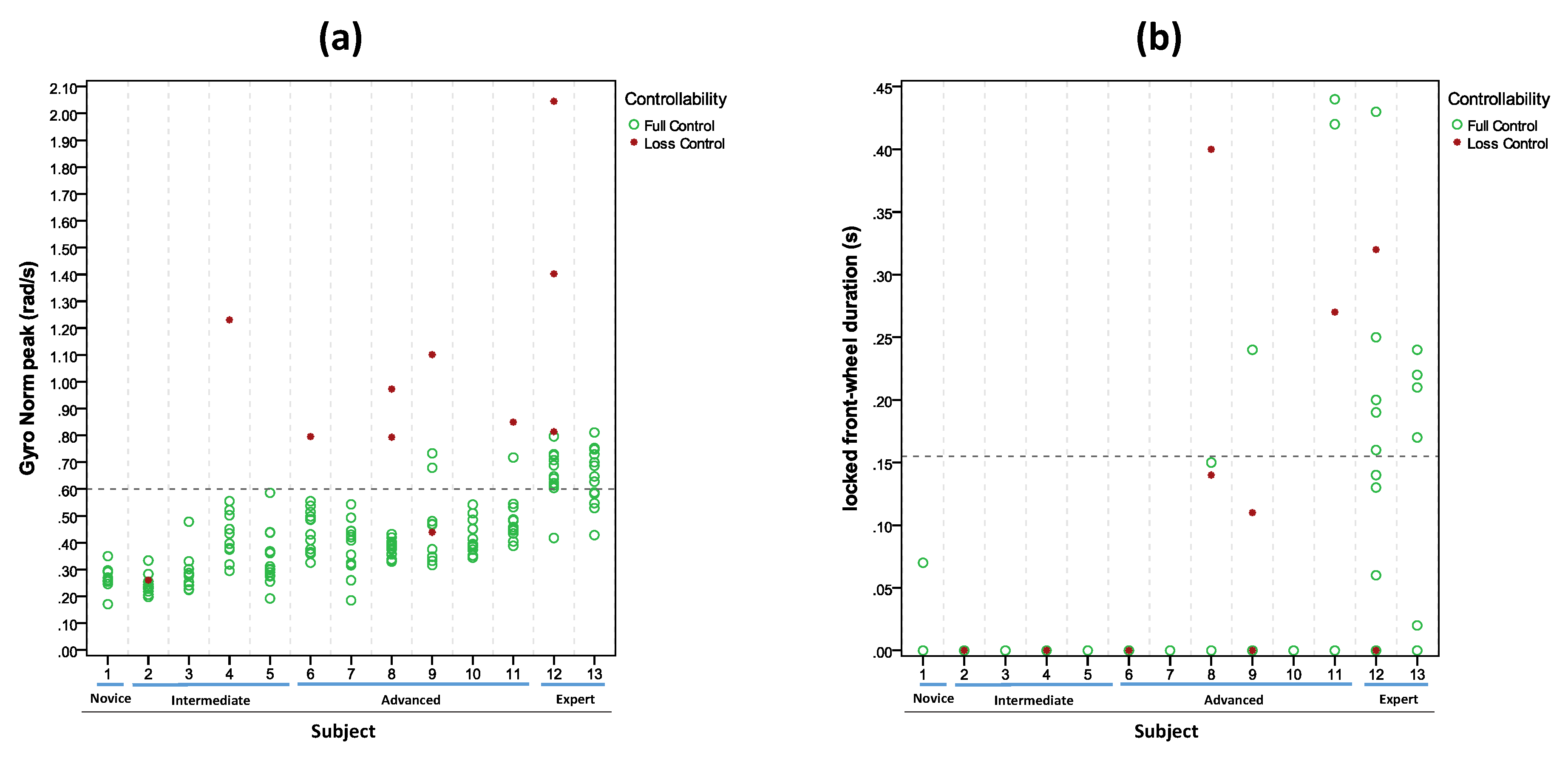
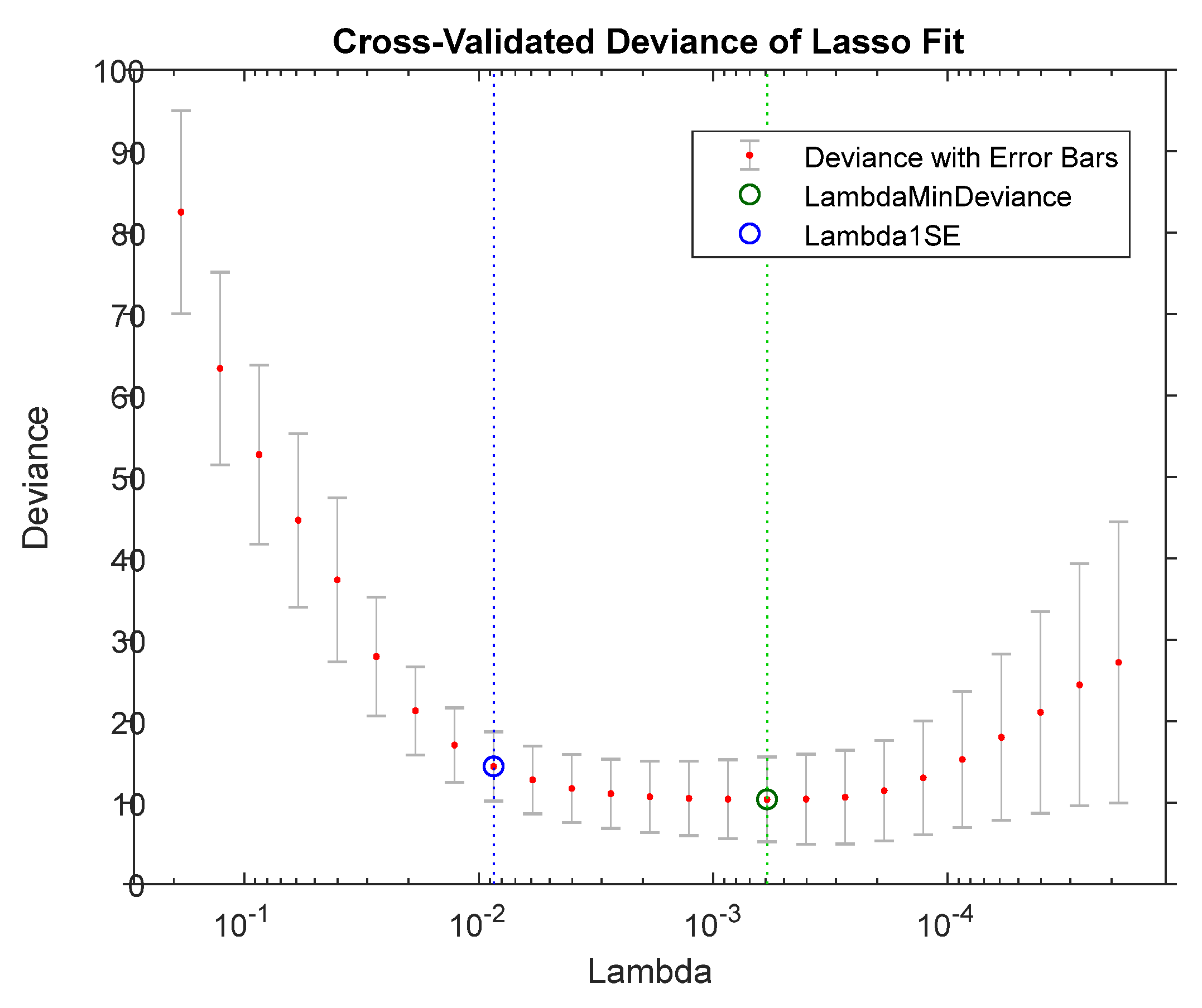
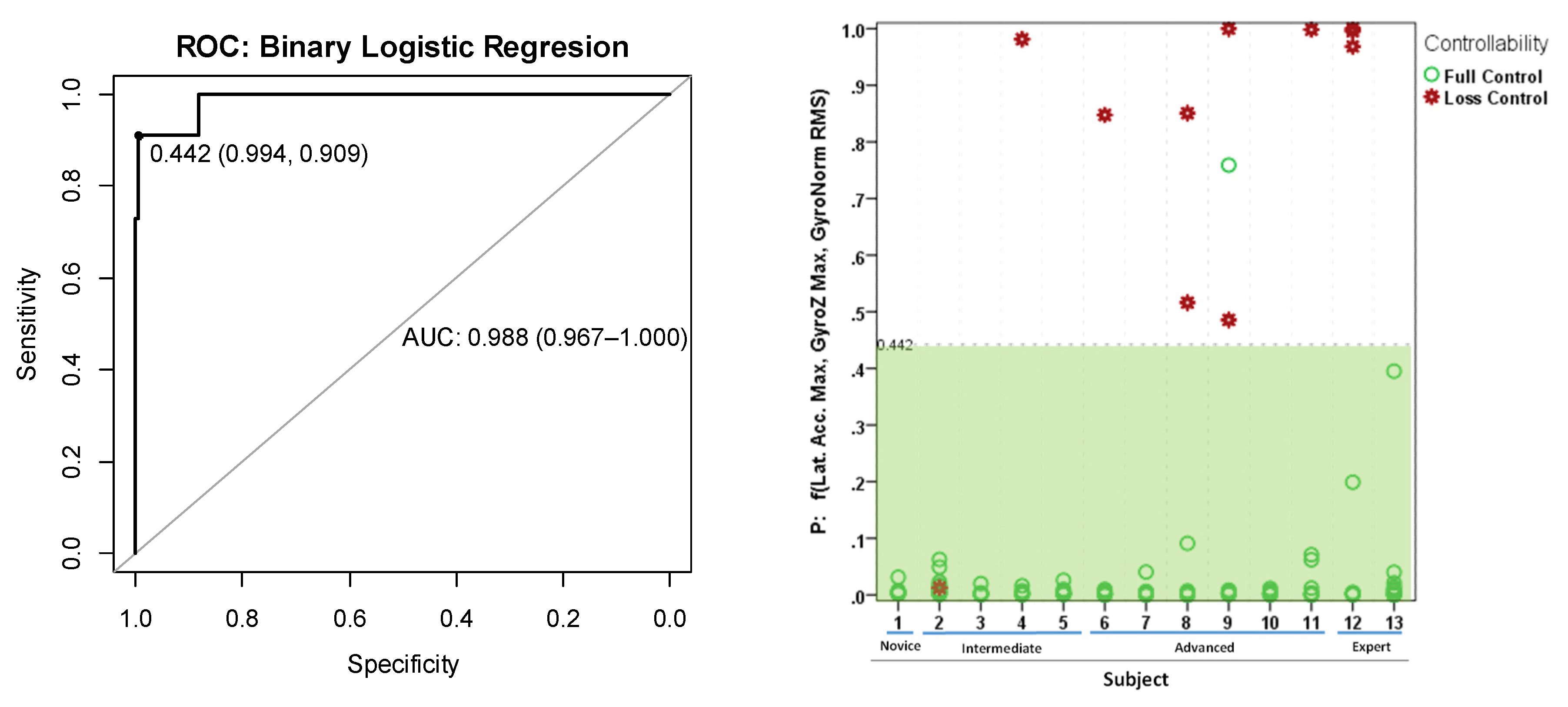
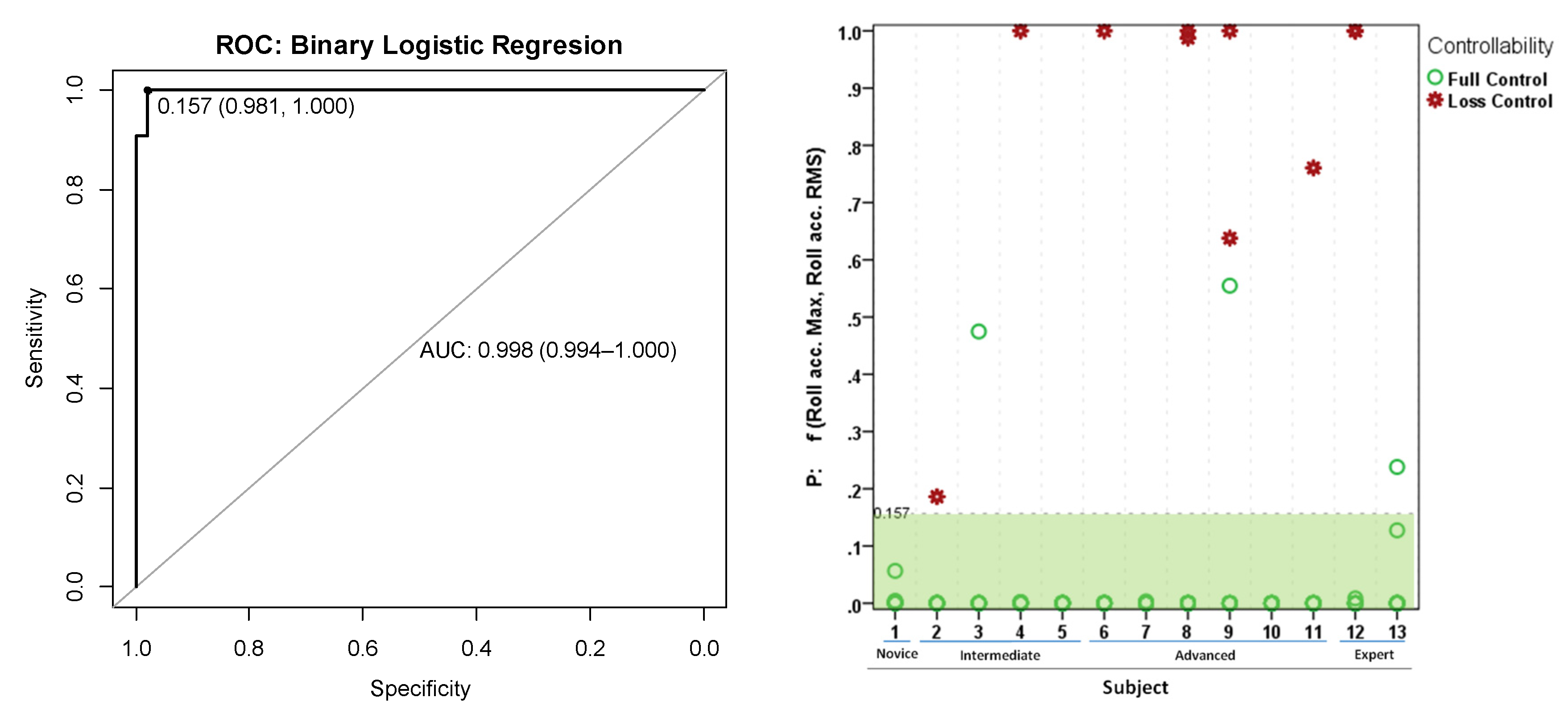

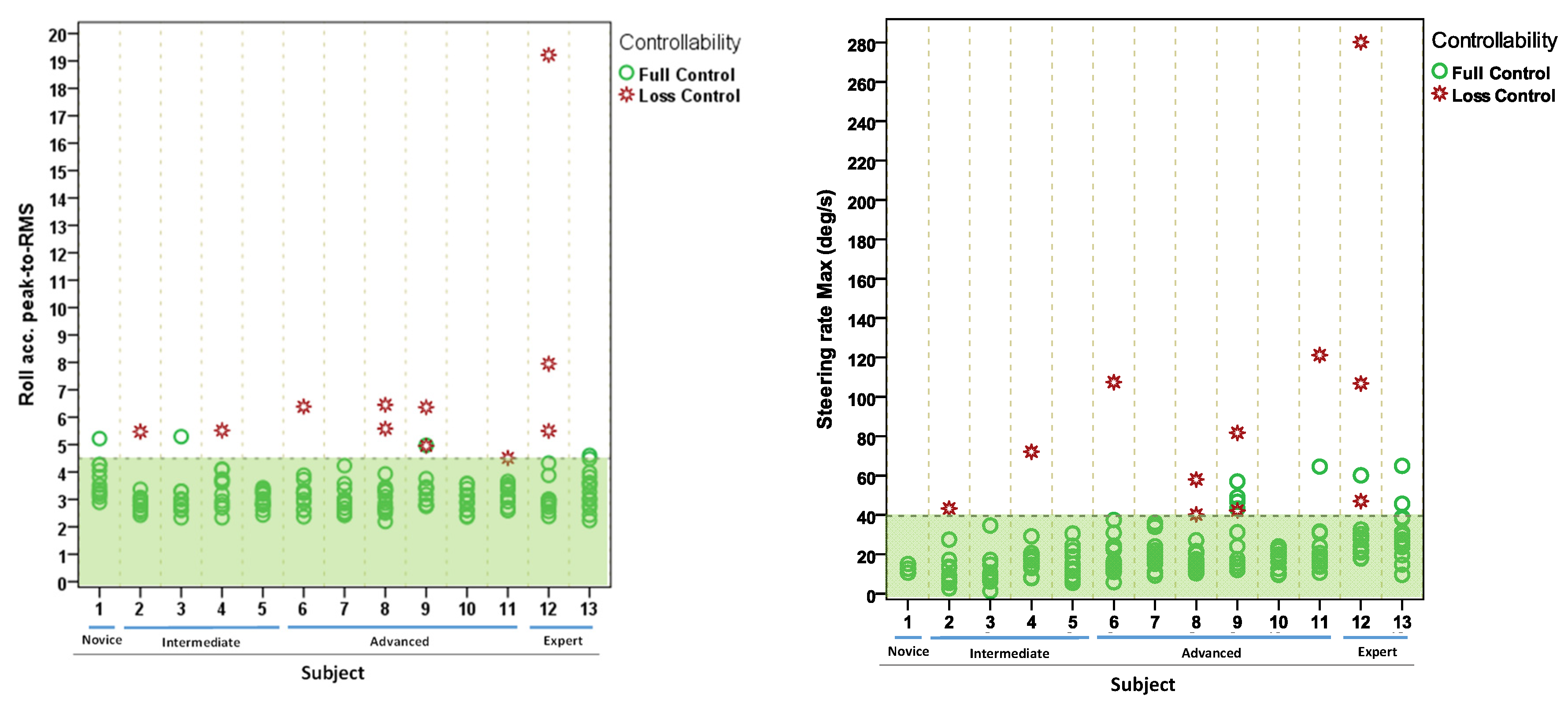
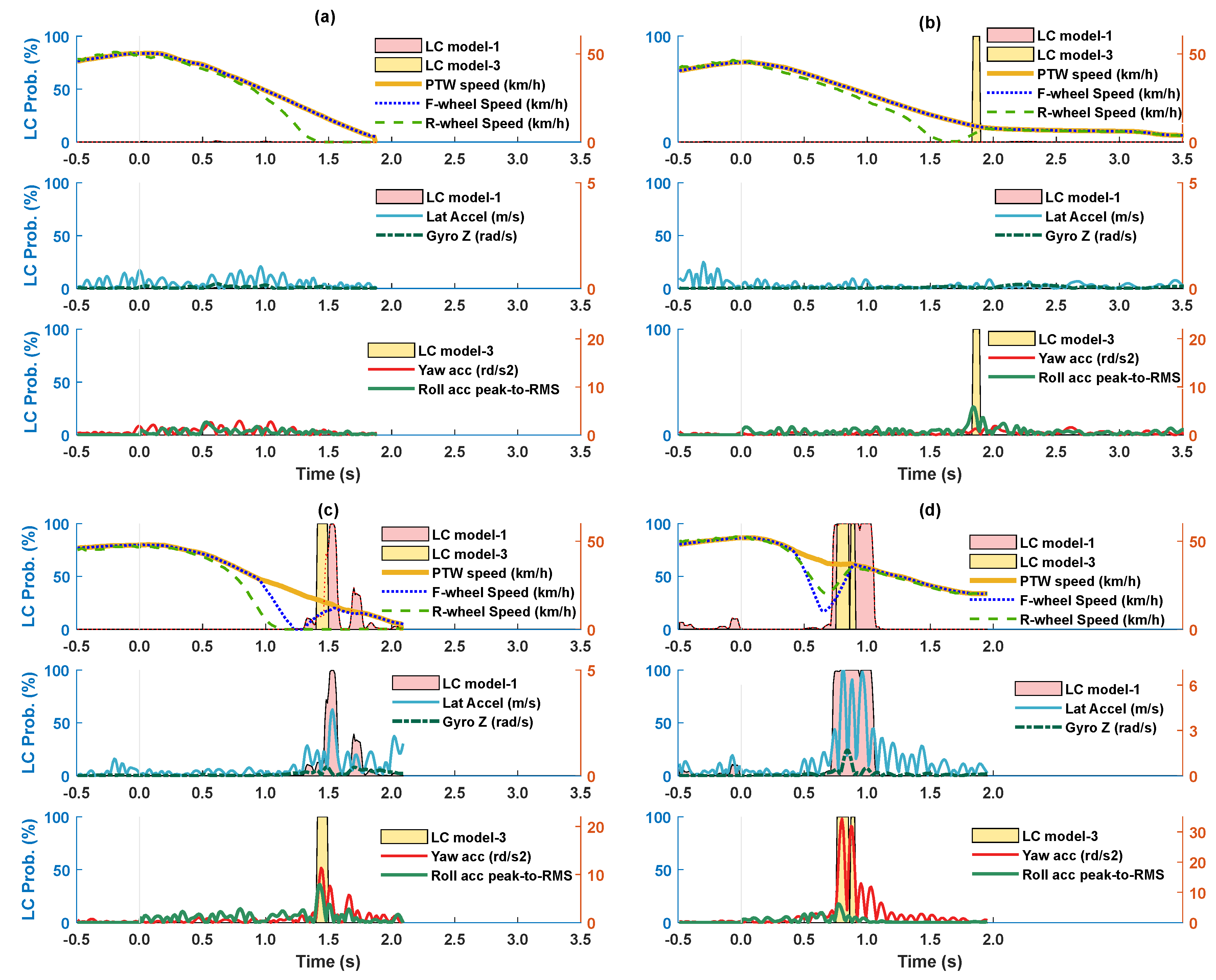
| β Coeff. | Std. Error | Wald | p-Values | |
|---|---|---|---|---|
| MODEL-1 | ||||
| Gyro Norm RMS | −36.9 | 19.2 | 3.619 | 0.057 |
| Lat Accel Max | 2.8 | 1.1 | 6.420 | 0.011 |
| Gyro-Z_Max | 20.6 | 7.9 | 6.595 | 0.010 |
| Intercept | −6.3 | 2.152 | 9.110 | 0.003 |
| MODEL-2 | ||||
| Roll Acc Max | 6.9 | 4.4 | 2.710 | 0.100 |
| Roll Acc RMS | −29.3 | 19.0 | 2.613 | 0.106 |
| Intercept | −5.7 | 3.3 | 3.287 | 0.070 |
| MODEL- | ||||
| Roll Acc peak-to-RMS | 203.5 | 3356.0 | 0.004 | 0.952 |
| Yaw Acc Max | 24.6 | 504.8 | 0.002 | 0.961 |
| Intercept | −1147.9 | 19010.4 | 0.004 | 0.952 |
| Predictor | Threshold | Specificity | Sensitivity | AUC (CI) | Hosmer-Lemeshow Test |
|---|---|---|---|---|---|
| Model-1 | 0.442 | 0.994 | 0.909 | 0.988 (0.968–1.00) | χ2(8) = 5.991; p = 0.648 |
| Model-2 | 0.157 | 0.981 | 1 | 0.998 (0.994–1.00) | χ2(8) = 0.449; p = 1.00; |
| Model-3 | 0.275 | 1 | 1 | 1.00 (1.00–1.00) | χ2(8) = 0.000; p = 1.00 |
| Predictor | Threshold | Specificity | Sensitivity | AUC (CI) |
|---|---|---|---|---|
| Roll Acc peak-to-RMS | 4.49 | 0.974 | 1 | 0.996 (0.989–1.00) |
| Steering rate Max (°/s) | 39.5 | 0.945 | 1 | 0.980 (0.960–1.00) |
| Gyro-Z Max (rad/s) | 0.269 | 0.922 | 0.909 | 0.970 (0.930–1.00) |
| Yaw Acc Max (rad/s2) | 5.6 | 0.994 | 0.818 | 0.943 (0.859–1.00) |
| Lat Accel Max (m/s2) | 1.85 | 0.955 | 0.909 | 0.911 (0.766–1.00) |
| Gyro Norm Max (rad/s) | 0.773 | 0.987 | 0.818 | 0.887 (0.728–1.00) |
| Lock front-wheel (s) | 0.09 | 0.903 | 0.455 | 0.673 (0.513–0.833) |
© 2020 by the authors. Licensee MDPI, Basel, Switzerland. This article is an open access article distributed under the terms and conditions of the Creative Commons Attribution (CC BY) license (http://creativecommons.org/licenses/by/4.0/).
Share and Cite
Huertas-Leyva, P.; Savino, G.; Baldanzini, N.; Pierini, M. Loss of Control Prediction for Motorcycles during Emergency Braking Maneuvers Using a Supervised Learning Algorithm. Appl. Sci. 2020, 10, 1754. https://doi.org/10.3390/app10051754
Huertas-Leyva P, Savino G, Baldanzini N, Pierini M. Loss of Control Prediction for Motorcycles during Emergency Braking Maneuvers Using a Supervised Learning Algorithm. Applied Sciences. 2020; 10(5):1754. https://doi.org/10.3390/app10051754
Chicago/Turabian StyleHuertas-Leyva, Pedro, Giovanni Savino, Niccolò Baldanzini, and Marco Pierini. 2020. "Loss of Control Prediction for Motorcycles during Emergency Braking Maneuvers Using a Supervised Learning Algorithm" Applied Sciences 10, no. 5: 1754. https://doi.org/10.3390/app10051754
APA StyleHuertas-Leyva, P., Savino, G., Baldanzini, N., & Pierini, M. (2020). Loss of Control Prediction for Motorcycles during Emergency Braking Maneuvers Using a Supervised Learning Algorithm. Applied Sciences, 10(5), 1754. https://doi.org/10.3390/app10051754





